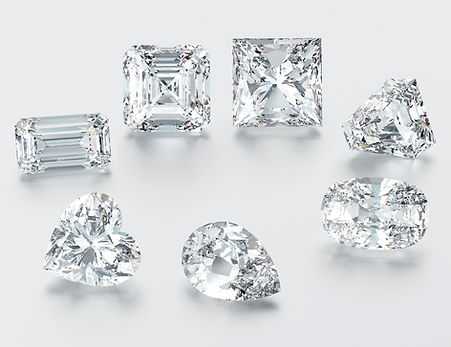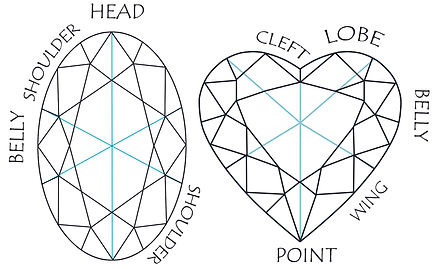Jewelry Artisan • Gemologist • Designer
SUPERIOR DETAIL AND ACCURACY

Text & Mobile 713-298-9405
Business 713-239-0812
Appointments Available
Mon-Sat 10am-5pm

Diamond Cut Grading
and
Fancy Shaped Diamonds
CUT
ONE OF THE MOST IMPORTANT ASPECTS
Cut is specifically for Round Brilliant Cut Diamonds. Fancy Shaped Diamonds do not receive a Cut grade from GIA. Unfortunately, people often confuse or miscommunicate diamond shape or finish with diamond Cut. The Shape of a diamond is the outward appearance. The Finish of a diamond is the Polish and Symmetry. These characteristics correlate with Cut, but none are considered Cut. When a Gemologist uses the word Cut, they are referring to the dimensions and angles of the diamond.
Cut breaks down all of this, facet by facet. A diamond's Cut plays a very large role in the Four Cs. A great Cut is the key to providing brilliance, fire, and sparkle to the diamond.
The Anatomy of a Modern Round Brilliant
WHAT DEFINES CLASSIC
From Round Brilliant Cut Diamonds to Fancy Shaped Diamonds, the Cut and Finish determines how much light return the diamond gives you. The better the Cut angles and percentages, the more brilliance you get.
Suppose a diamond is not cut properly. With a deep Pavilion, light enters the diamond and falls out the bottom. With acute Pavilion angles, light can simply fall straight through the stone; cutting down its brilliance completely.

CUT GRADES FOR MODERN ROUND BRILLIANT CUT DIAMONDS
Excellent Cut diamonds have maximum brilliance and light return. Excellent, or premium cuts are equivalent to Ideal cuts, but you will pay a bit more.
Very Good Cut diamonds return large amounts of light, providing a great amount of brilliance to the diamond. They are a great choice.
Good Cut diamonds return most of the light that passes through them, but you will see a minimal amount of light leakage.
Fair Cut diamonds have a small amount of light return. They are grayish in appearance and have a noticable amount of light leakage.
Poor diamond Cuts have little to no light return. You often see large gray and black sections throughout the diamond face up.
FANCY SHAPED DIAMONDS
ANY GEMSTONE SHAPE OTHER THAN ROUND
Any diamond that is cut beyond a Round Brilliant Cut is regarded as a Fancy Cut, or a Fancy Shaped Diamond. There are many shapes; like Cushions, Ovals, and Pears to name a few. There is no Cut Grade issued for a Fancy Shaped Diamond. They are graded by the sum of their parts. The overall look of a Fancy Shaped Diamond's Shape Appeal is sometimes more important than the definitive details that are vital to a Round Brilliant Cut Diamond.


FANCY SHAPED DIAMOND PARTS
When referring to Fancy Shaped Diamond Cuts, communicating what you are looking for in a shape is important to know. The preference in shape is known as Shape Appeal.
Should you prefer a long Oval Shape, you would be looking for narrow shoulders and a small belly, where as, a stocky Oval would have wide shoulders and a wide belly.
The factors used to evaluate Round Brilliant Cuts are precise; given the equivalent distance from CenterPoint.
The angles and percentages vary in Fancy Shaped Diamonds.

In fact, because cuts and measurements differ so much, diamond shapes with bellies can tend to have bow ties. Faint, light gray ones are often seen in diamonds with bellies. It is very hard to eliminate a bow tie altogether. They are most noticeable in shallow or very deep stones. When light exits the bottom and leaves extinction, or black shadowing, in the form of a bow tie, it is referred to as the Bow Tie Effect. (see above)
THREE CUT CATEGORIES
The are three main diamond cutting styles that all diamond manufacturers use. They are Brilliant Cuts, Step Cuts, and Mixed Cuts.
Patented Diamond Cuts come and go. You will usually pay a premium for a patented cut because you cannot find them just anywhere. Some are very beautiful. Unfortunately, most Patented Cuts do not hold their value as a Classic Cut Diamond would.
All Patented Diamond Cuts follow these three footprints. Patented Cuts are also a manufacturer's way to sell, or offer, a unique cut that no one else provides. Examples of these cuts are Kay's Leo Cut, Tiffany's Lucida Cut, and Jared's Royal Asscher Cut. There are more. Even the Radiant Cut was patented. The patent has since expired. Yet, the Radiant Cut, unlike the others above, has withstood the test of time. It is now considered a Classic Cut though GIA chooses to label it as Modified Brilliant Cut (Mixed Cut.)
These cut parameters are applied to all diamonds, including patented cuts.
















